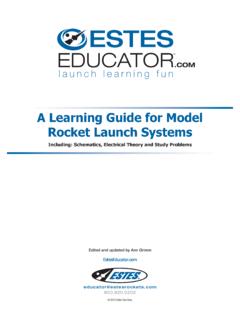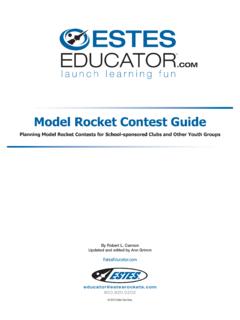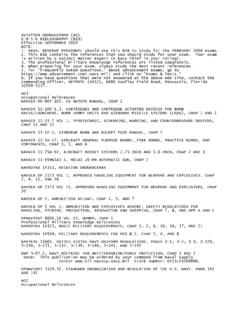Transcription of Mathematics and Model Rockets
1 Mathematics and Model RocketsA Teacher s Guide and Curriculum for Grades 5-12 2012 Estes-Cox Developed by Sylvia Nolte, Ed. D. Based on coursework by Harold McConnell, Ph. by James H. Kranich Jr., and Ann 2 EDUCATOR ESTES 3 EDUCATOR TABLE OF and Background for the Plans ..8-451. Lesson 1: Introduction to Unit Demonstration: Launching a Model Lesson 2: Finding the Center of Mass ..11-133. Lesson 3: Finding the Center of Pressure ..14-194. Lesson 4: rocket Stability ..20-235. Lesson 5: Math and rocket Flight ..24-41 Launching a RocketGathering Data and StatisticsCalculations6. Lesson 6: (Extension) Aerial Photography ..42-447. Lesson 7: (Extension) Launching Payloads ..45-46 Bibliography ..47 AppendixBlackline Masters, Student Worksheets ..48-84 Overhead 4 EDUCATOR INTRODUCTIONMATHEMATICS AND Model ROCKETSM odel rocketry is an extremely useful tool for teaching students in amath classroom.
2 Model rocketry captures the students interest andinvolves them in applying math concepts in a real and authentic way. Itinvolves them in experimenting and testing their ideas. Using modelrocket projects in a math curriculum aids students in learning to usecreative and critical thinking and problem-solving skills. It providesopportunities for them to discover underlying principles of rocketry also allows curriculum integration by combining math,science, craftsmanship, physical education, prediction, language arts,history, technology and research methods. It provides opportunities forcooperative learning as well as experiences that will have definitepersonal meaning to the students through the constructing and launchingof their own rocket . Two other curriculum guides from Estes that may be useful are, Scienceand Model Rockets for Grades 5, 6, 7, 8and Physics and ModelRockets for Grades 8, 9, 10 & 11.
3 Science and Model Rockets hasunits that give directions for constructing Model Rockets , doing simplealtitude tracking, simple math and data collection. Physics and ModelRockets relates Newton s Laws of Motion to Model rocketry. Thesetwo guides can be used with the current guide to develop a well-integratedscience and math curriculum guide is constructed so that teachers of students fromfifth through twelfth grade will find it useful. Units include activities thatcan be used to support basic concepts and to extend students who havethe knowledge and ability to work at a more advanced level. The guidecan be used as a complete unit or individual projects may be selected touse if the students have the math and science background needed tounderstand it. Each group of students is different with a variety of experience andinterests.
4 Providing a number of projects allows the teacher and thestudents to work on activities related to the design of Model Rockets andthe mathematical analysis of the effects of the design on Model functionthat relate to those individual experiences and interests. The teacher willbe able to adapt the unit to fit an individual class. GOALSS tudents will understand the connection between math and will use math in practical applications related to will recognize the importance of careful construction of a modelrocket for stability, safety and a successful 5 EDUCATOR STUDENT OUTCOMESThe student will be able to: Determine the center of mass experimentally, graphically and/ormathematically. Recognize the importance of the center of mass in rocket flight as thepoint around which an unstable rocket tumbles.
5 Recognize the significance of the location of the center of pressure inrelation to the location of the center of gravity(center of mass) inproviding stability for a Model rocket . Determine mathematically the centroid and area of a variety of shapes. Determine the lateral center of pressure for a Model rocket . Recognize the importance of stability in Model rocket flight and testthe stability of their own rocket . Track the flight of Model Rockets to gather data to calculate height,velocities and accelerations. Use mathematical equations to determine velocities and accelerationsduring the rocket flight and describe their relationship to Newton sSecond SKILLS Observing Reading and following directions and diagrams Problem-solving AnalysisGENERAL BACKGROUND FOR THE TEACHERS tability is the single most important consideration in designing a modelrocket.
6 The more stable the rocket , the more it tends to rotate (weather-cock) into the wind during flight. A stable rocket is one that flies in asmooth, uniform direction. An unstable rocket flies along an erratic path,sometimes tumbling or changing direction. Unstable Rockets are danger-ous because it is not possible to predict where they will go. All matter, regardless of size, mass or shape, has a point inside called thecenter of mass. The center of mass is the exact spot where all of the massof that object is perfectly balanced. The center of mass of an object suchas a ruler can be demonstrated by balancing it on your finger. The centerof mass can be demonstrated graphically to determine the effect ofadding increasing weight to one end of an object such as a rocket addition to the center of mass, the center of pressure inside the rocketaffects its flight.
7 When air is flowing past a moving rocket it rubs andpushes against the outer surface of the rocket , causing it to begin movingaround the center of mass. Think of a weather vane. The arrow is attachedto a vertical rod that acts as a pivot point. The arrow is balanced so thatthe center of mass is right at the pivot point. When the wind blows, the ESTES 6 EDUCATOR arrow turns, and the head of the arrow points into the oncoming tail of the arrow points in the downwind direction. The reasons forthis is that the tail of the arrow has a much larger surface area than thearrowhead. The flowing air imparts a greater force to the tail than thehead and the tail is pushed away. Similar to the concept of the center ofmass, there is a precise point in the arrow where all the aerodynamicforces acting on it are perfectly balanced.
8 This spot is called the center ofpressure. It is not the same as the center of mass. The center of pressureis between the center of mass and the tail end of the arrow. The tail endhas more surface area than the head end. The lateral center of pressurehas to do only with the forces applied to the surface directly by air cur-rents. The larger the surface the greater the forces will be. Stability is dependent upon the relationship between the center of massand the center of pressure. The center of pressure in a rocket must belocated toward the tail and the center of mass must be located toward thenose. If they are in the same place or very near each other, then therocket will be unstable in flight. The center of mass may be moved forward by adding weight to the noseof the rocket .
9 The center of pressure may be moved toward the rear bymoving the fins back, increasing their size or by adding fins. The centerof pressure can be moved forward by using smaller fins. Calculating the ratio of length to diameter in a rocket will help determinethe potential for stability in a design. An ideal ratio is 10 to 1 (a 1-inchdiameter rocket with a length of 10 inches, for example). Newton s Three Laws of Motion1. Objects at rest will stay at rest, and objects in motion will stay inmotion in a straight line at constant velocity unless acted upon by anunbalanced understand this law it is necessary to understand the terms: rest,motion and unbalanced and motion can be thought of as opposite. Rest is the state of anobject when it is not changing position in relation to its cannot be defined as a total absence of motion because it could notexist in nature.
10 All matter in the universe is moving all the time, but inthe first law of motion, motion means changing position in relation tosurroundings. When an object is at rest, the forces acting upon it arebalanced. In order for an object to begin moving, the forces acting uponit must become Model rocket is at rest when it is on the launch pad. The forces actingupon it are balanced. The force of gravity is pulling the rocket downwardand the rocket launch pad is pushing against it holding it up. When thepropellant in the engine is ignited, that provides an unbalanced force. Therocket is then set in motion and would stay in a straight line until otherunbalanced forces act upon 7 EDUCATOR 2. Force is equal to mass times is really a mathematical equation, f = ma. This equation applies tolaunching the rocket off the launch pad.











